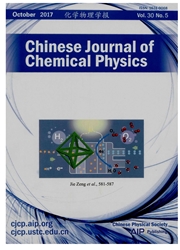

 中文摘要:
中文摘要:
在对一系列抗癌性7,8-二烃基-1,3-二氨基吡咯-[3,2-f]喹唑啉类二氢叶酸还原酶抑制剂的二维定量构效关系(2D—QSAa)研究基础上,应用比较分子场分析法对该类配合物进行了三维定量构效关系(3D—QSAR)研究.建立了具有良好的统计学性能及预报能力的3D.QSAR模型,非交叉验证相关系数为0.993,交叉验证相关系数为0.619,估算的标准误差0.208,统计方差比193.4.该模型表明立体场因素的影响比静电场因素大很多,此结果与我们已经报道的2D—QSAR模型结果相一致.然而,3D—QSAR模型提供了可视化的立体场、静电场因素对活性的影响.3D—QSAR研究对实验上提出的二氢叶酸还原酶与药物分子的疏水键合作用机理得到了进一步的理论解释.
 英文摘要:
英文摘要:
A three-dimensional quantitative structure-activity relationship (3D-QSAR) study of a series of 7,8-dialkyl-l,3-diaminopyrrolo-[3,2-f] quinazolines with anticancer activity as dihydrofo- late reductase (DHFR) inhibitors was carried out by using the comparative molecular field analysis (CoMFA), on the basis of our reported 2D-QSAR of these compounds. The es- tablished 3D-QSAR model has good quality of statistics and good prediction ability; the non cross-validation correlation coefficient and the cross-validation value of this model are 0.993 and 0.619, respectively, the F value is 193.4, and the standard deviation SD is 0.208. This model indicates that the steric field factor plays a much more important role than the electrostatic one, in satisfying agreement with the published 2D-QSAR model. However, the 3D-QSAR model offers visual images of the steric field and the electrostatic field. The 3D-QSAR study further suggests the following: to improve the activity, the substituent R^1 should be selected to be a group with an adaptive bulk like Et or i-Pr, and the substituent R should be selected to be a larger alkyl. In particular, based on our present 3D-QSAR as well as the published 2D-QSAR, the experimentMly-proposed hydrophobic binding mechanism on the receptor-binding site of the DHFR can be further explained in theory. Therefore, the QSAR studies help to further understand the "hydrophobic binding" action mechanism of this kind of compounds, and to direct the molecular design of new drugs with higher activity.
 同期刊论文项目
同期刊论文项目
 同项目期刊论文
同项目期刊论文
 期刊信息
期刊信息
